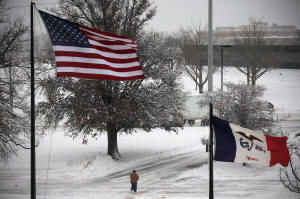Massive winter storm batters US, knocks out power ahead of brutal freeze
 Send a link to a friend
Send a link to a friend
 [January 10, 2024]
By Scott DiSavino [January 10, 2024]
By Scott DiSavino
(Reuters) -A massive winter storm moving across the eastern half of the
U.S. on Tuesday knocked out power to about 811,000 homes and businesses
in 12 states ahead of a brutal freeze expected to blanket the region
starting this weekend.
The hardest hit states so far are New York and Pennsylvania, each with
about 182,000 power outages, and New Jersey with over 127,000 outages,
according to data from PowerOutage.us.
The biggest power companies in those states are units of Con Edison in
New York, FirstEnergy in Pennsylvania and Public Service Electric and
Gas, a subsidiary of The Public Service Enterprise Group in New Jersey.
Extreme weather is a reminder of the February freeze in 2021 that left
millions in Texas and other U.S. Central states without power, water and
heat for days, and a winter storm in December 2022 - known as Elliott in
the energy industry - that almost caused the collapse of power and
natural gas systems in parts of the eastern half of the country.
The current storm is covering most of the country east of the
Mississippi River, according to AccuWeather.com. It is moving toward the
U.S. Northeast.

The storm is coming ahead of what will likely be the nation's coldest
weather since December 2022, according to data from financial firm LSEG.
LSEG projected gas demand, used to heat about half the homes in the
country, would reach a daily record of 170.0 billion cubic feet per day
(bcfd) on Jan. 15 and 173.7 bcfd on Jan. 16.
Traders noted it would be unusual for gas use to hit a record on Jan. 15
since it is the U.S. Martin Luther King Day holiday when many businesses
and government offices will be shut for a long weekend.
If correct, gas demand, including exports, on Jan. 15 and 16 would top
the current daily record of 162.5 bcfd set on Dec. 23, 2022, according
to federal energy data from S&P Global Commodities Insights.
[to top of second column]
|

A person walks in snow and high winds as a winter storm moves
through the midwest United States in Des Moines, Iowa, U.S., January
9, 2024. REUTERS/Mike Segar

One billion cubic feet is enough gas to fuel about 5 million U.S.
homes for a day.
Despite the coming cold, spot power and gas prices have not reacted
much to the current storm, but gas futures have soared about 30%
over the past six days and were trading at a two-month high of
around $3.25 per million British thermal units. [NGA/]
DECEMBER 2022 STORM
The December 2022 storm caused some energy companies, including the
Tennessee Valley Authority and Duke, to impose rotating outages to
maintain electric reliability after dozens of power plants failed to
operate.
Gas flows into pipelines were also reduced during that storm, as
output declined due in part to the freezing of gas wells, pipes and
other equipment. At the same time, demand for gas for heating and
power generation soared, dramatically lowering line pressures.
In New York City, Consolidated Edison was forced to declare an
emergency because it faced a gas system collapse that would have
taken "many months" to restore service in the middle of the winter.
(Reporting by Scott DiSavino, Additional reporting by Daksh Grover
and Harshit Verma in Bengaluru; editing by Jonathan Oatis, Aurora
Ellis, Deepa Babington and Sonali Paul)
[© 2023 Thomson Reuters. All rights
reserved.]This material
may not be published, broadcast, rewritten or redistributed.
Thompson Reuters is solely responsible for this content.
 |